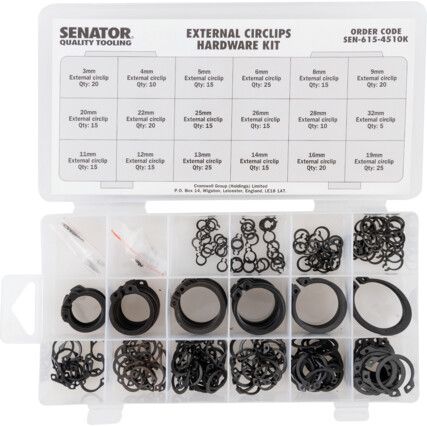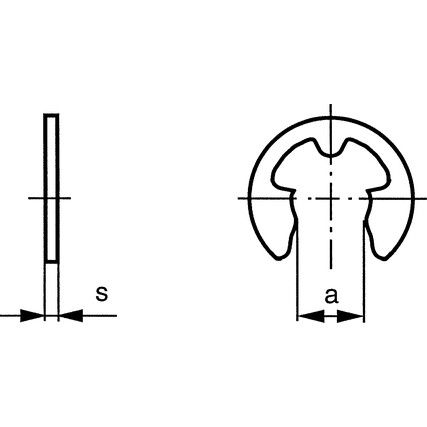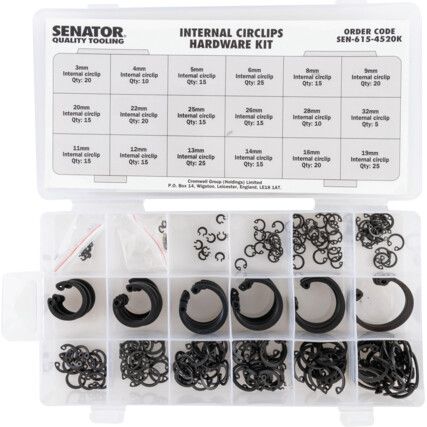Circlips
Known by many names, including retaining rings, snap rings, E-clips and Jesus clips, circlip fasteners play an important part in securing dowel pins in rotating mechanisms.
These adaptable, open-ended rings are mostly fitted axially into or onto a duct or shaft using circlip pliers. Similar to a lock ring, they achieve good contact when fitted correctly and can withstand high rotational speeds.
Circlips fit tightly either externally on the outer part of a shaft or housing, or internally on a groove in the shaft to form a secure retaining shoulder that keeps rotating mechanisms firmly in place. You can find a wide range of circlip sets and their accessories on Cromwell.co.uk from our own brands, Senator® and Qualfast®.
What are circlips?
Available in both internal and external variations, circlips are fitted to rotating mechanisms as a retaining component for parts that are subject to high rotational speeds.
Why circlips?
Circlips are a strong, load-bearing mechanism that helps to eliminate the issues of clearance to allow rotary mechanisms to be securely fitted while maintaining their function.
When are circlips used?
Used heavily in industrial machinery applications, larger versions are used for wind turbines in the renewable energy sector.
Circlip types
As previously discussed, there are two main types of circlips: internal and external. However, there are a wide variety of styles designed to benefit different types of applications.
• Constant section retaining rings - Used both internally and externally, this style maintains a consistent density with no tapered edges. When fitted the rings change shape to provide contact with the shaft at three or more points.
• Spiral retention rings - A spiral-shaped variation of constant-section retaining rings, these circlips are fitted in the same way, but provide full contact with the housing once installed.
• Tapered-section circlip - Engineered with a dense centre and tapered ends, this design holds its shape for complete contact with the shaft.
• Inverted circlip - Very similar to constant-section circlips, but with grooved ends, this style is mostly used for larger applications.
• Increased abutment circlip - With tapered ends and evenly spaced lugs around their circumference, these are often referred to as star clips or K circlips. Used for offset machine parts, the lugs deliver an even-strength distribution.
• Grip rings - Internal only, these circlips don't require a groove for fitting. Their tighter grip keeps them secured in place, but they can be tricky to both fit and remove.
• E circlip - These internal circlips are fitted radially into a groove which allows for convenient removal even when placed between other fittings.
Circlip jargon buster
There are several standards associated with circlips and it can get a little confusing. To help you understand the range, we've taken a British standard and broken down its meaning to keep you better informed when making your purchase.
What does BS 3673-4:1977 mean?
This standard features the technical specifications required for the safe production of spring retaining rings, or circlips, made from carbon steel.
Let's break it down...
• BS - This is an acronym for British Standards and means that this standard has been prepared and published by the British Standards Institution.
• 3673 - This is the assigned legislation number
• 4 - This is the part of the legislation document that is relevant to the product in question
• 1977 - This is the year that this standard for circlips was updated and replaced Part 1 of the standard
FAQs
What are circlips made of?
For both strength and flexibility, circlips are often made from carbon steel. However, there are variations made from stainless steel, phosphate spring steel and phosphor bronze.
How do you remove C clips?
Some circlips are easier to remove than others, but where there are lug holes, a set of circlip pliers can be used to both fit and remove them. Circlip plier sets can be found at Cromwell online. Why not speak to our experts and get advice on which set would be best for you.
How are circlips measured?
To find the right size circlip for your task, you must first decide if the component you need is external or internal. External circlips are chosen based on the shaft or housing size the clip will be fitted to, essentially, the inner diameter of the clip.
Internal circlips are sized in the opposite way, and the size of the bore dictates the size of the clip, or the external diameter is measured to get the correct sized clip for the job.
Similarly, circlip pliers are chosen based on the internal or external diameter measurements to ensure easy fitting.
Can circlips be reused?
We don't recommend that you reuse circlips. The flexible spring nature of their design can lead to shape changes during fitting which might compromise their strength if used again elsewhere.



